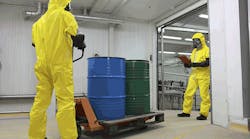OSHA’s new Hazard Communications Standard (HCS) goes into effect on June 1, 2015, and while the agency promises initially to go easy on enforcement in certain respects, it also is expected to make additional changes that will expand the program to new chemicals in a matter of months.
In 2012 OSHA modified its HCS program to bring it into line with the United Nations Globally Harmonized System (GHS) of chemical classification and labeling. By signing onto the UN program, the U.S. pledged to make sweeping changes in its own hazmat regulations and labeling requirement, although they were little noticed by participants in the distribution industry in this country initially, including many third-party logistics warehouse providers.
After June 1, any containers shipped from a chemical manufacturer or importer must include the new GHS-style label. (The new HCS employee training requirements already had gone into effect on December 1, 2013.)
On December 1, 2015, distributors are required to make sure that all shipped containers are properly labeled. Additional training requirements are slated to go into effect on June 1, 2016.
In addition to small changes in familiar terminology—for example, Material Safety Data Sheets are now known as Safety Data Sheets (SDS)—the HCS contains other, more sweeping changes. Federal designs for placards and labels were revised radically from their former familiar designs to match international standards, which require entirely different colors, shapes and symbols.
In addition, under the 2012 standard employers now must maintain 17 different kinds of Safety Data Sheets, covering areas that now include hazard and toxicological identification and ingredients composition information; transport, handling, storage and disposal information; and first aid, fire-fighting and accidental release handling measures.
Employers must have a GHS-style, 16-section SDS for each chemical which is considered to be a health or physical hazard. A health hazard is defined as a chemical with acute toxicity (any route of exposure); skin corrosion or irritation; serious eye damage or eye irritation; respiratory or skin sensitization; germ cell mutagenicity; carcinogenicity; reproductive toxicity; specific target organ toxicity (single or repeated exposure); or aspiration hazard.
A physical hazard is any chemical that is explosive; flammable (gases, aerosols, liquids, or solids); oxidizer (liquid, solid or gas); self-reactive; pyrophoric (liquid or solid); self-heating; organic peroxide; corrosive to metal; gas under pressure; or if in contact with water emits flammable gas.
Who Is Expected to Comply?
The standards apply to distributors and importers as well as to manufacturers—in fact to all businesses with one or more employees handling these chemicals. (Office environments that may have some of these chemicals present in the form of consumer products, like cleaning solvents and printer ink, for example, are exempted.)
Less stringent requirements apply to businesses like warehouses that only handle chemicals in sealed containers. They do not need written hazard communication programs or to maintain lists of chemicals. However, these employers are required to keep labels on containers after they are received, maintain material safety data sheets received and give employees access to them, and maintain information for their employees and train them.
In a February 2015 memorandum OSHA said it will not issue citations against manufacturers, importers, or distributors who have exercised “reasonable diligence” and made a “good faith” effort to classify and label their chemical mixtures and if the safety data sheets and labels comply with the 1994 HCS requirements.
But don’t consider this to be an easy out. OSHA has instructed its compliance officers to look at whether these businesses:
• Developed and documented the process used to gather classification information from its upstream suppliers and the status of such efforts.
• Developed and documented efforts to find hazard information from alternative sources such as chemical registries.
• Provided a written account of continued dialogue with the upstream suppliers, including dated copies of all relevant written communications.
• Provided a written account of continued dialogue with distributors, including dated copies of written communications with distributors informing them why it has been unable to comply.
• Developed the course of action it will follow to make the necessary changes to the SDSs and labels.
For distributors unable to ship compliant Safety Data Sheets by December 1, 2015, because of a manufacturer or importer’s inability to comply with the June 1, 2015, effective date, OSHA compliance officers will consider whether they also exercised reasonable diligence and acted in good faith, and whether they effectively documented communications with manufacturers or importers about reasons for noncompliance.
While it is not clear if the OSHA inspector will look for the same five factors applied to manufacturers and importers, having a well-documented file of communications with manufacturers and importers may help demonstrate there is no need for an OSHA citation.
For more information on how OSHA intends to pursue its compliance efforts, including answers provided for some commonly asked questions, see here. For more details of the HCS program as a whole, see here.
In another development, OSHA has said that it is considering expanding the list of chemicals covered by the program because the United Nations is working on further revisions of its standards, which could include significant changes.
The American Chemistry Council has expressed concern about the announcement by OSHA that it intends to propose even more changes while employers are still hard at work trying to comply with the previous revisions.
“ACC supports the goal of harmonizing GHS requirements around the world, and in particular with the approaches taken by major trading partners,” the council said. “We would have concerns, however, over any proposals to change the 2012 Hazard Communication Standard before it is even implemented.”



